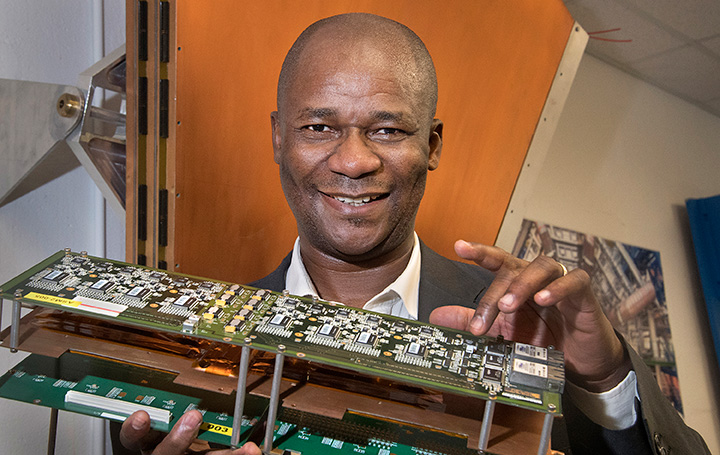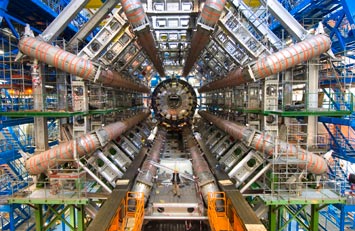Meet Kétévi Assamagan, Physicist and Explorer
February 28, 2017
 enlarge
enlarge
Brookhaven Lab's Kétévi Assamagan shows sample components from the ATLAS detector's muon spectrometer for which he developed software.
Assamagan is a physicist at the U.S. Department of Energy's (DOE) Brookhaven National Laboratory. From Brookhaven—and anywhere else he needs to be and can charge his laptop—Assamagan explores huge quantities of data from the Large Hadron Collider (LHC) at CERN in Europe in search of new physics—potential holes and contradictions in the Standard Model of Particle Physics that describes the universe's most basic building blocks and explains how they interact.
"The Standard Model of Particle Physics is successful as a theoretical model that describes what we see in nature, but it's not a complete picture," Assamagan explained. "Some 'missing' proof emerged in data from the LHC when we found the Higgs particle predicted in the Standard Model. But even with the Higgs, the Standard Model doesn't describe everything we have evidence of."
The long-sought Higgs is a subatomic particle scientists in the ATLAS and CMS collaborations discovered from particle collisions at the LHC in 2012, using large detectors that can be more than 50 feet tall and weigh millions of pounds. Discovering this particle provided evidence of the Higgs field that gives mass to other elementary particles, according to the Standard Model. The discovery also led to the 2013 Nobel Prize in Physics being awarded to theoretical physicists Peter Higgs and Francois Englert, who predicted the particle's existence nearly 50 years earlier.
The ATLAS collaboration comprises 2,800 scientists and students—plus engineers and technicians—from 38 countries, including Assamagan, and as the U.S. host laboratory, Brookhaven Lab has held multiple roles, from construction and project management to distributing data and operating and upgrading the detector. Similarly, Assamagan had a number of roles in the collaboration as well. As the ATLAS Higgs group convener, he led a group that prepared the framework for computer software that analyzed LHC collision data, contributing to the Higgs discovery. He also developed software for the ATLAS detector’s muon spectrometer, which identifies and measures the trajectory and momentum of particles called muons that, as described by the Standard Model, are similar to electrons with much greater mass.
Finding Answers to Big Questions
Some of the big questions the Standard Model leaves unanswered for physicists like Assamagan include "What is dark matter?" which has been detected from gravitational effects, but remains invisible, as well as "How did the universe end up with more matter than antimatter?" and "How would the theory be affected if gravity was not omitted?"
"My interest is to understand the fundamental interactions between matter and force, and how the universe became what it is now," Assamagan said, explaining that he scours data from LHC particle collisions and mathematical simulations in search of clues of dark matter, supersymmetry, extra dimensions, and other proposed theories that may fill in the Standard Model's gaps.
These current questions are rooted in knowledge from hundreds and thousands of years of advances—by Archimedes, Newton, Einstein, and countless others. Pursuing answers to today's questions at the farthest frontiers of physics requires brilliance and commitment from scientists, engineers, and technicians, who operate major facilities like the LHC and the Relativistic Heavy Ion Collider (RHIC), a DOE Office of Science User Facility located at Brookhaven Lab, where scientists are both studying the "strong force" that confines subatomic quarks and gluons in all the universe's protons and neutrons as well as addressing the "proton spin crisis," hunting for an explanation as to why the proton's spin is not equal to the sum of the spins of its parts. It's continuing experiments at facilities like these that provide scientists with evidence to answer current questions and fuel future theoretical predictions.
This is not a journey one scientist can walk alone, literally or figuratively.
"We have a lot of interactions and a lot of scrutiny about where we can search for new physics, how best we can search for it, and how we can achieve conclusive data about what to pursue next," Assamagan said.
 enlarge
enlarge
Inside the ATLAS collaboration's detector at the Large Hadron Collider. As the U.S. host laboratory for the collaboration, Brookhaven Lab has held multiple roles, from construction and project management to distributing data and operating and upgrading the detector. Assamagan led a group that prepared framework for the detector's computer software. Image credit: CERN
Assamagan is also a member of Brookhaven Lab’s African American Affinity Group and an organizing committee member of the African School of Physics, where scientists from around the world travel to Africa to introduce students there to the physics theories, experiments, and technologies that power major collaborations like ATLAS and the experiments at RHIC. And since moving to Wading River, where Assamagan lives with his wife and daughter, he's taken on a new hobby not common in his tropical former homeland of Togo: ice skating!
Brookhaven National Laboratory is supported by the Office of Science of the U.S. Department of Energy. The Office of Science is the single largest supporter of basic research in the physical sciences in the United States, and is working to address some of the most pressing challenges of our time. For more information, please visit science.energy.gov.
2017-12044 | INT/EXT | Newsroom









